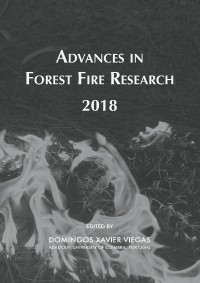Please use this identifier to cite or link to this item:
https://hdl.handle.net/10316.2/44660| DC Field | Value | Language |
|---|---|---|
| dc.contributor.author | Fletcher, Thomas H. | |
| dc.contributor.author | Safdari, Mohammad-Saeed | |
| dc.contributor.author | Amini, Elham | |
| dc.contributor.author | Weise, David R. | |
| dc.date.accessioned | 2018-11-11T09:59:56Z | |
| dc.date.accessioned | 2020-09-06T17:30:51Z | - |
| dc.date.available | 2018-11-11T09:59:56Z | |
| dc.date.available | 2020-09-06T17:30:51Z | - |
| dc.date.issued | 2018 | - |
| dc.identifier.isbn | 978-989-26-16-506 (PDF) | |
| dc.identifier.uri | https://hdl.handle.net/10316.2/44660 | - |
| dc.description.abstract | Prescribed burning (controlled burning) is used to decrease accumulation of combustible materials and reduce impact of uncontrolled wildland fires. Prescribed fires are often used to burn undergrowth in southern forests of the United States. In order to improve prescribed fire application, accomplish desired fire effects, and limit potential runaway fires, an improved understanding of the fundamental processes related to combustion of heterogeneous fuel beds of live and dead fuels is needed. The initial processes of combustion involve pyrolysis and ignition. During this research, fast pyrolysis of 14 live and dead (biomass) plant species which are native to the southern United States have been studied using a flat-flame burner (FFB) apparatus. The FFB apparatus enables experiments at a high heating rate (~100°C s-1, or ~100 kW m-2) and moderate temperature (~765°C) to imitate pyrolysis during typical fire spread conditions. Pyrolysis products have been analyzed in detail using a gas chromatograph equipped with a mass spectrometer (GC-MS) for analysis of tars, and a gas chromatograph equipped with a thermal conductivity detector (GC-TCD) for analysis of permanent (light or non-condensable) gases. Differences between yields of light gas species were small between plant species. Composition of tars included aromatic compounds with 1 to 5 rings with very few attachments. The pyrolysis products observed at this temperature and heating rate appear to have experienced secondary pyrolysis. The tar composition showed some large changes with plant species. Comparison of products from pyrolysis of live vegetation and dead vegetation of the same plant species showed differences in tar, gas, and char yields, but no major changes in the types of chemical compounds observed. | eng |
| dc.language.iso | eng | - |
| dc.publisher | Imprensa da Universidade de Coimbra | por |
| dc.relation.ispartof | http://hdl.handle.net/10316.2/44517 | por |
| dc.rights | open access | - |
| dc.subject | pyrolysis | eng |
| dc.subject | live shrubs | eng |
| dc.title | Bench-scale measurement of pyrolysis products from intact live fuels | por |
| dc.type | bookPart | por |
| uc.publication.firstPage | 1223 | - |
| uc.publication.lastPage | 1226 | - |
| uc.publication.location | Coimbra | por |
| dc.identifier.doi | 10.14195/978-989-26-16-506_143 | - |
| uc.publication.section | Chapter 7 - Short Contributions | por |
| uc.publication.digCollection | PB | por |
| uc.publication.orderno | 143 | - |
| uc.publication.area | Ciências da Engenharia e Tecnologias | por |
| uc.publication.bookTitle | Advances in forest fire research 2018 | - |
| uc.publication.manifest | https://dl.uc.pt/json/iiif/10316.2/44660/203783/manifest?manifest=/json/iiif/10316.2/44660/203783/manifest | - |
| uc.publication.thumbnail | https://dl.uc.pt/retrieve/11055815 | - |
| uc.publication.parentItemId | 55072 | - |
| uc.itemId | 68740 | - |
| item.grantfulltext | open | - |
| item.fulltext | With Fulltext | - |
| Appears in Collections: | Advances in forest fire research 2018 | |
Files in This Item:
| File | Description | Size | Format | |
|---|---|---|---|---|
| bench-scale_measurement_of_pyrolysis.pdf | 718.41 kB | Adobe PDF |  |
Items in DSpace are protected by copyright, with all rights reserved, unless otherwise indicated.
